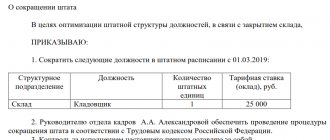Personnel rotation as a way to develop employees
Personnel rotation is the horizontal movement of employees from one position to another within the same company, division or department.
Personnel rotation differs from career advancement (vertical movement) in that the employee remains at the same level in the job hierarchy, but the range of his tasks differs from those in his previously held position.
Personnel rotation is... (types, goals and practical meaning of personnel rotation in an organization)
Posted by Ledi 08/03/2012 at 20:00
Category: Relocation of employees Tags: types of rotation, advantages of rotation, personnel rotation, difficulties of personnel rotation, rotation goals
Discussion: No comments
It has long been known that the effective development of a company is greatly facilitated by a close-knit team of experienced specialists. But where to get them? – you might ask. Grow within the organization itself, for example, using a tool such as “personnel rotation.”
Personnel rotation is the horizontal movement of employees to various positions within the same company
Personnel rotation (from the Latin rotatio - circular movement) is the horizontal movement of employees to various positions within the same company.
Remember! To carry out rotation in an organization, the written consent of each transferred employee is required!
Types of rotation
Several classifications of rotation are known.
According to the trajectory of movement there are:
- Ring - moving from one position to another in a certain period of time with a return eventually to the starting position
- Irrevocable - transfer from one position to another without returning to the original
- Castling – the transfer of two employees to each other’s workplaces within the same level
By frequency or speed of personnel movement:
- Annual
- Monthly
- Daily
- Hourly
By level of specialization:
- In a related specialty
- In a completely different specialty
- In the same specialty, but with a change in the nature of the work
- In the same specialty, but without a significant change in the nature of the work
According to who initiated the proposal:
- Administration
- HR service
- The employee himself
Rotation goals
- Train workers in related professions, turning them into universal specialists
- Familiarize staff with the maximum number of production tasks in the organization
- Test the flexibility of employees and their ability to navigate a new, non-standard situation
- Form a personnel reserve, especially management
- Relieve mental stress in critical areas of work, in some cases prevent conflicts
- Avoid diseases among personnel when working in hazardous industries
Remember! The main success of any rotation is a clearly formulated purpose for its implementation.
Benefits of rotation for the employee and the company as a whole
Rotation is an excellent reason for an employee:
Castling – the transfer of two employees to each other’s workplaces within the same level
- Master related professions and, accordingly, new functions and responsibilities
- Accumulate practical experience, gain versatile knowledge, thereby gaining greater scope for personal professional development
- Compare positions, try your hand at different areas and choose the most suitable option for yourself
- Move to a position that allows vertical career growth
- Increase satisfaction from the work done. The absence of routine duties encourages the employee to invest as much effort as possible and achieve success.
As a result, by allowing an employee to try his hand at various fields, the company receives the most competent and erudite specialist.
Properly developed and implemented personnel rotation gives the organization the following advantages:
- Renewal of personnel without increasing the number of staff units. Rotation encourages employees to show initiative and activity in a new workplace, which contributes to the emergence of fresh ideas and achievements
- Increasing the interchangeability of employees, which is especially important in connection with illnesses, vacations, and an increase in the volume of work at any site
- Improving communications among company employees, the emergence of healthy competition
- Reducing the cost of training employees, eliminating the need for expensive training to teach the necessary professional skills. Everything is learned by employees in practice directly at the workplace
- Reducing the cost of searching for specialists on the external labor market
- Reduced staff turnover. The employee clearly sees prospects for career and professional development, as a result of which his loyalty to the organization increases
How long can a person stay in one position?
There are factors that can be taken into account to determine the optimal length of stay for an employee in a certain position. This:
- Rotation goals
- Time spent on adaptation (gaining new knowledge, skills, abilities in a new position). Depends on the complexity of the work
- Intensity and duration of mental operations
- Degree of routine work
- Stress level
- Degree of physical activity
- Degree of harmfulness, health hazard
- Characteristics of a particular employee (age, gender, temperament, etc.)
- Features of the team and the organization as a whole
Difficulties in personnel rotation
As with any business, rotation has its difficulties. If you know about them in advance, you can easily reduce them to a minimum.
- Decrease in productivity due to long or protracted adaptation of a person to a new position
- Costs of training displaced people
- Improperly organized personnel movement threatens conflicts. Therefore, it is advisable to have a detailed personnel rotation plan, agreed upon with the management and heads of all departments, thought out to the smallest detail.
- People may refuse to move from “good” positions to “bad” ones in their opinion. Therefore, the reshuffle should be carried out fairly, and easy and difficult positions should be distributed evenly. It is mandatory to carry out explanatory work among employees about what personnel rotation is, what its goals are, features, benefits for each person, etc.
Often executives and HR managers have a question: what to do with people who have a highly specialized profession, such as an accountant, programmer, lawyer, etc.? We believe that all employees of the organization should be in equal conditions, that is, they need to be transferred too. This measure will help break up the routine of current responsibilities and improve communications.
The personnel rotation system is the key to a successful organization
Rotation is the most effective method of developing employees, each of whom can reveal a completely unexpected side. This will undoubtedly play a positive role both for himself and for the entire company as a whole.
Assessing the work of a novice copywriter
Staff turnover rate
Dismissal during the probationary period
Rotation goals
The goals pursued by the employer when rotating personnel can be varied:
- employee training in related professions;
- checking the employee’s versatility and flexibility;
- creating a personnel reserve in case of illness, vacations, etc.;
- familiarizing employees with the company’s objectives;
- relieving emotional stress to avoid conflict situations between employees or between an employee and an employer;
- change of work environment.
Results
Having dealt with the question of what personnel rotation is, it becomes clear that the operation is a separate element of the sphere of personnel management in the company. Its use is a guarantee of successful entrepreneurial activity due to the constant support of employees in good shape, which motivates them to fully and efficiently perform their job duties. This approach has a direct impact on the performance indicators of a business entity.
https://youtu.be/J61AJ9z_018
Types of rotation
There are three main types of rotation. They depend on the trajectory of workers.
For example, with a circular rotation, an employee works for a certain time in a new position, after which he returns to his previous job.
With irrevocable rotation, the employee remains in a new position without returning to the previously occupied one. Castling allows you to swap positions between two employees on the same level.
Difficulties in staff rotation
Relocation does not always benefit the employee and the company itself, because after the transfer a person may experience professional and personal difficulties. Mastering new responsibilities and changing the direction of activity may not suit the employee. But even if he copes with professional responsibilities, problems may arise with adaptation to a new team or mastering a new social role. A person may even get into conflicts when his role expectations are not confirmed.
Personnel rotation must be carried out on a legal and regular basis. The entire process must be regulated, clearly organized and recorded in the staffing table. The employee is warned about the move in advance.
Typically, staff rotation benefits the company and has a positive effect on employee motivation and the development of their careers, but before making a decision, you need to carefully weigh its pros and cons depending on the characteristics of the employees and the specifics of the activity.
The Omega company is ready to offer you personnel outsourcing and outstaffing services. We take a responsible approach to the issue of team building and are able to offer experienced and qualified specialists. To discuss details, call the number.
Benefits of Rotation
Rotation will be useful for both the manager and the subordinate. In the first case, this means obtaining interchangeable and universal workers without expanding the staff, increasing team cohesion, and reducing staff turnover.
In the second case, gaining practical experience in new professions, the opportunity to compare different positions, and prospects for career growth.
Rotation as a method of personnel development
The head of a company interested in its promotion must pay attention to the psychological mood of his employees. To do this, he needs to provide them with opportunities for personal and professional growth. When planning activities aimed at creating a favorable working climate in the team, you should take into account the existing stages of personnel development:
- preparatory;
- formation;
- growth.
At the preparatory stage, a person is trained and identified with a profession that would help him express himself, unlock his potential and satisfy his financial needs. The growth of professional development begins from this time, subject to the correct choice of field of activity.
At the formation stage, a person masters a profession and increases the level of his qualifications. The period of a person’s professional growth usually coincides with his age of 30–45 years. At this time, he strives for independence and high status, which is not difficult if he has knowledge and practical skills.
Types of rotation
A person achieves professional mastery in his field by the age of 45. If during this period he is provided with the conditions necessary for career growth, then this approach will maximize the employee’s potential and bring benefits to the company.
Rotation Weaknesses
During rotation, the organization may face some difficulties. Firstly, productivity decreases due to long adaptation. Secondly, retraining costs are required.
Thirdly, conflict situations may arise if the displaced person considers the administration’s choice unfair or unreasonable. But, knowing these difficulties, the company will be able to reduce them to a minimum.
Personnel rotation is a tool that allows an organization to develop its employees, to reveal their potential from unexpected sides, which has a positive effect on the performance of subordinates and on the company as a whole.
Benefits of Rotation
Note that rotation is carried out both at manufacturing enterprises and in government bodies. For example, in the civil service, rotation is usually carried out with the aim of increasing the efficiency of use of personnel and preventing corruption. But it is worth noting that in this case the rotation is carried out in one group or category of government positions.
Rotation also contributes to job satisfaction; with rotation, some routine and monotony in work disappears.
Also, temporary relocation allows you to organize work on the interchangeability of personnel in the company. Another advantage of carrying out rotation within one enterprise or organization is the improvement of organizational and corporate culture, interpersonal relationships among company personnel, as the employee moves to another department. Which means to a different work team.
Some specialists in the field of personnel work emphasize that after staff rotation, a positive effect is observed, such as a significant reduction in staff turnover .










